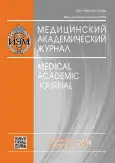EXPERIMENTAL MODEL OF CFS: COGNITIVE, PHYSICAL AND METABOLIC CHARACTERISTICS OF PATHOLOGY DEVELOPMENT
- Authors: Filatenkova TA1, Shanin SN1, Fomicheva EE1, Korneva EA1,2, Serebryanaya NB1,2,3
-
Affiliations:
- Institute of Experimental Medicine, Saint Petersburg
- Saint Petersburg State University, Saint Petersburg
- North-Western State Medical University named after I.I. Mechnikov, Saint Petersburg
- Issue: Vol 19, No 1S (2019)
- Pages: 74-76
- Section: Articles
- Published: 15.12.2019
- URL: https://journals.eco-vector.com/MAJ/article/view/19332
- ID: 19332
Cite item
Abstract
In the present study, an analysis of cognitive, behavioral, and metabolic changes during the dynamics of the development of pathology was conducted under an experimental model of chronic fatigue syndrome (CFS). A decrease in physical and research activity of experimental animals indicated the development of fatigue and a depressed emotional state. An increase in the concentration of lactate was also showed, that may indicate a violation of the energy metabolism.
Keywords
Full Text
About the authors
T A Filatenkova
Institute of Experimental Medicine, Saint Petersburg
S N Shanin
Institute of Experimental Medicine, Saint Petersburg
E E Fomicheva
Institute of Experimental Medicine, Saint Petersburg
E A Korneva
Institute of Experimental Medicine, Saint Petersburg; Saint Petersburg State University, Saint Petersburg
N B Serebryanaya
Institute of Experimental Medicine, Saint Petersburg; Saint Petersburg State University, Saint Petersburg; North-Western State Medical University named after I.I. Mechnikov, Saint Petersburg
References
- Artsimovich NG, Galushina TS. Chronic fatigue syndrome. Moscow: New World; 2002. 350 p.
- James N. A Cronic Fatique Syndrome severity score based on case design criteria. Am J Transl Res. 2013;5(1):53-68.
- Amoak S. Investigating unexplained CFS. BMC Family Practice. 2016;17:81.
- Katafuchi T, Kondo T, Yasaka T, et al. Prolonged effects of polyriboinosinic: Induced by fatigue. Neuroscience. 2003;120(3):837-45.
- Fomicheva EE, Rybakina EG, Filatenkova TA. Activity of the hypothalamic-pituitary-adrenocortical system in the induction of chronic fatigue syndrome in the experiment. Russian Fiziol. Journal im. I.M. Se¬chenov. 2009;95(1):11-18.
- George A. Brooks What is glycolysis? Journal of Applied Physiology. 2010;108(6):1450-1451.
Supplementary files







